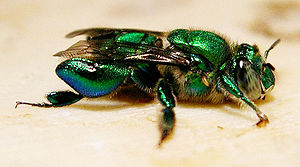Magnificent bees
| Magnificent bees | ||||||||||||
|---|---|---|---|---|---|---|---|---|---|---|---|---|

Male specimen of a Euglossa spec. |
||||||||||||
| Systematics | ||||||||||||
|
||||||||||||
| Scientific name | ||||||||||||
| Euglossini | ||||||||||||
| Latreille , 1802 |
The magnificent bees or orchid bees (Euglossini) are a tribe from the family of real bees (Apidae). This group includes around 200 described species , divided into five genera . An older assignment is that of the cup collectors .
description
Most species are solitary, but some group together or show simple forms of eusocial behavior. All five genera, Euglossa , Eulaema , Eufriesea , Exaerete and Aglae , occur exclusively in tropical South and Central America. The representatives of the last two genera are kleptoparasites in the nests of other magnificent bees. All magnificent bees, except those of the genus Eulaema , are characterized by a striking, metallic shimmering color in green, gold and blue tones.
Collection of fragrances
In male jewel bees, the tibia of the hind legs are transformed into a unique structure that is used to collect and store various volatile compounds (often esters ). These substances are mainly collected from orchid flowers , which offer neither nectar nor pollen , and then released again at certain places where mating has also been observed. Although it is believed that these fragrances are used to communicate with the females, an attractiveness or effect on the reproductive success of the males has not been proven. With the help of these fragrances, the male orchid bees can be easily attracted and caught for study purposes. Some of the fragrances are also perceptible as pleasant for humans, such as methyl salicylate , eugenol , cineol , benzyl acetate , methyl benzoate and methyl cinnamate , others as unpleasant, such as skatole .
pollination
Many neotropical orchid species have developed complex mechanisms in order to attach pollen packages ( pollinia ) to certain parts of their bodies for male bees . The differences in the placement of the pollinia ensure that pollination only works within the same orchid species. In addition, different types of splendor bees are attracted to different substances in the plants, so that there is a certain specialization of a splendor bee species on certain orchid species. Charles Darwin gave an early description of these pollination conditions, but he considered the bees involved to be females. The pollination of the magnificent bees is known as euglossophilia , a subspecies of melittophilia , it is divided into andro (only the males) and gynandro euglossophilia (males and females).
literature
- Michael S. Engel: The first fossil Euglossa and phylogeny of the orchid bees (Hymenoptera: Apidae; Euglossini). In: American Museum Novitates. 3272: 1999, 1–14, online (PDF; 2.8 MB), on hdl.handle.net, accessed on October 11, 2017.
Web links
Individual evidence
- ↑ DW Roubik, PE Hanson: Orchid bees of tropical America: biology and field guide. 2004, ISBN 9968-702-94-3 .
- ↑ FP Schiestl, DW Roubik: Odor Compound Detection in Male euglossine Bees. In: Journal of Chemical Ecology. 29 (1): 2003, pp. 253-257, doi : 10.1023 / A: 1021932131526 .
- ^ Charles Darwin, D. Appleton: The Various Contrivances by which Orchids are Fertilized by Insects. 1877, limited preview in Google Book search.
- ↑ Joachim W. Kadereit, K. Kubitzki: The Families and Generas of Vascular Plants. Vol.VII: Flowering Plants - Dicotyledons , Springer, 2004, ISBN 978-3-642-62200-7 , p. 82.
